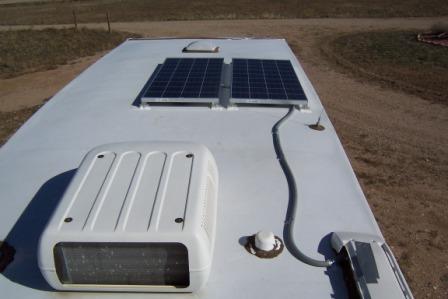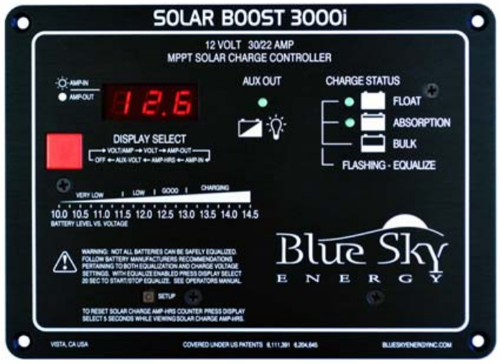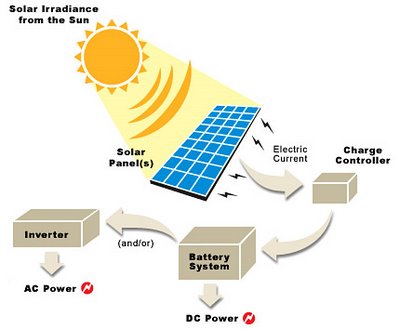
If you are one of the thousands of people fascinated with the idea of RVing off-the-grid, then this article is for you. Boondocking, or dry camping, is the practice of camping outside of an established campground and functioning without the need of hookups such as water, power or sewer.
For some this idea sounds exciting and freeing, and for others it just seems plain difficult. The truth is that most people who are interested in boondocking want to know how to doing it without a lot of hassle. Today we are taking a look one of the most important aspects of boodocking how to — power. More specifically, the basics of using solar energy to power your RV while boondocking.
Boondocking doesn’t mean living off canned food heated over a candle. For most off-the-grid RVers, electricity comes from one of two sources — a generator (either a built in diesel driven generator or a portable gas generator) or solar power. Many people have both options and switch between the two, depending on their immediate need and the weather.
In recent years solar panels have grown in popularity and dropped in cost. These panels convert energy from the sun into low voltage direct current that is stored within a battery system. The batteries store the power until you need it. When the sun goes down you can draw power from the batteries to run electrical items within your RV. From microwaves and TVs, to laptops and phones, nearly all your electrical needs can be met by using your stored solar energy.
Some people take things a step farther and install an inverter. This item is hooked up to the battery and your RVs electrical system. The inverter takes the DC battery power and converts it into AC power which can be used with your electrical devices.
These three items (solar panels, batteries and the inverter) work together to create energy without the ongoing cost. This energy is available to you, anywhere you travel as long as you have sun. You can literally be hundreds of miles from the nearest RV hookup without altering your lifestyle. (Can you say WOW!)
If you are new to boondocking, you may be wondering if this type of system can work for you. Would you be able to install a solar system that would allow you to travel without the need of plugging in and sf so, what do you need to get started?
First things first. Every RV family has different needs and their rig requires different amounts of power. In order to better understand how to figure out what you personally need let’s start with a basic plan.
How Much Power Do You Use?
Let’s say Mr. and Mrs. RV want to keep the lights on for four hours a day. They take a shower every two days, so they need electricity for their water pump. They also like to wash their dishes so they need electricity for that as well. In total, they run the water pump about 45 minutes every day. In the evenings, Mr and Mrs. RV watch some TV. Mr. RV loves to catch up on his news, and Mrs. RV watches reality TV. In all they consume 3 hours a day.
When the weather gets cool the couple turns on their furnace for about two hours, which warms the rig and takes the chill off.
If we add it all together Mr. and Mrs. RV will consume about 43 amp hours of electricity every day. Amp hours are the way solar devices measure usage.
Storage Solutions
Now that we know how many amp hours Mr and Mrs. RV will use, we need to figure out how much storage they need to hold 43 amp hours of energy charge.
Most people think that electrical items like a microwave is getting its power straight from the solar panel. But what about when the sun stops shinning and you still need to cook your pizza pockets?
The answer is you need a way to store the energy that the panels bring in. For solar, the best storage your RV batteries. These batteries serve as a savings account that allows you to deposit built up energy throughout the day. In the evening you can withdraw the stored energy as needed. The batteries you will use to store your solar energy are specially designed to store large amounts of current for a long time.
These batteries are different than traditional vehicle batteries. They are not designed to jump start your engine. Instead, they are made to hold energy for a longer period of time and slowly discharge as needed. These batteries will be used thousands of times charging and recharging so they have to be built to last.
Now it’s time to figure out how much storage Mr. and Mrs. RV are actually going to use. Since we know they are going to use 43 amp hours each day and they want enough power for two days that means the batteries need to hold at least 86 amp hours. Sounds simple right?
But what if the sun doesn’t shine for a couple days? Or what if something comes up and they need more amp hours then estimated? This scenario is sure to happen, which is why it’s best to choose batteries with the capacity to hold more than you will need.
As a general rule, it’s a good idea to batteries that that will hold four times your daily need. With 172 amp hours of storage you can run your battery down to half every two days and still have extra just in case you need it. When shopping for batteries you want to have more than you need. If the average 12 volt battery holds 80 amp hours that means you need three batteries. This would provide you with the 172 amp hours, which puts you in the safe zone. The extra amp hours provide a cushion, or an energy bank, for the future.
How Much Solar Power?
We now know that our battery capacity will hold up to 240 amp hours, but many solar panels will we need?
Every amp hour requires a 1/2 watt of solar panel power. In order to get that many watts the panel will require full sun with absolutely no shade. Every time shade creeps across the panels, energy gathering is diminished. Your goal is to gain six solid hours of sunshine each day.
Which means Mr. and Mrs. RV will need at least a 120 watts solar panel to meet their daily power needs. It’s important to note that a single solar panel is usually not be enough. Most people will want AT LEAST two panels.
Regulate the Power
It is possible for a solar panel to overcharge and cook your batteries. To avoid this crisis you need an automated switch which controls the flow of solar energy into your battery. This switch will turn on and allow power out of the batteries at night and shut the flow down when the batteries are full. This solar regulator helps keep your system operational and safe.
How Much Will it Cost?
Mr. and Mrs. RV are on a budget so it will take some time to shop around and find the best prices. Now that they know how many watts they need they can begin the process.
When searching online they may discover a simple 200 watt solar panel package that allows them to mount their panels on their roof. It comes with a solar regulator and sells for about $350.
In addition, they will need batteries, wiring and an inverter. If they don’t like the idea of self installation they will need to pay for an installer. For this example they could probably buy the entire system and have it installed for under $1,000.
Mr. Mrs. RV Bring The Family
If Mr. and Mrs. RV bring their family on vacation, they may need a lot more power. What can they do? In most cases, they can expand their system by adding additional panels and wiring. If they bought big enough batteries, they won’t need to add extras when they purchase more panels.
Where To Buy The System
There are lots of great places to purchase solar systems online. Here are a few places you may want to check:
Want more detailed information? If you really want to dive into the deep end and learn a whole lot more about solar this article by Technomadia can’t be beat! Also check out our guide to RV solar panels.
Looking for a real life example of how solar works in your day to day Boondocking? This video by Gone With The Wynns is awesome!
What do you think? Are you ready to hook up your RV with a solar set-up? Have you ever done Boondocking with or without solar? What do you think is the scariest part of learning how to use a solar system?
Add your comments in the box below, then share this helpful article with your Boondocking friends. Thanks!
Source: RV Boondocking News













